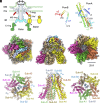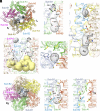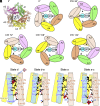Structural insight into sodium ion pathway in the bacterial flagellar stator from marine Vibrio
- PMID: 39793043
- PMCID: PMC11725901
- DOI: 10.1073/pnas.2415713122
Structural insight into sodium ion pathway in the bacterial flagellar stator from marine Vibrio
Abstract
Many bacteria swim in liquid or swarm on surface using the flagellum rotated by a motor driven by specific ion flow. The motor consists of the rotor and stator, and the stator converts the energy of ion flow to mechanical rotation. However, the ion pathway and the mechanism of stator rotation coupled with specific ion flow are still obscure. Here, we determined the structures of the sodium-driven stator of Vibrio, namely PomAB, in the presence and absence of sodium ions and the structure with its specific inhibitor, phenamil, by cryo-electron microscopy. The structures and following functional analysis revealed the sodium ion pathway, the mechanism of ion selectivity, and the inhibition mechanism by phenamil. We propose a model of sodium ion flow coupled with the stator rotation based on the structures. This work provides insights into the molecular mechanisms of ion specificity and conversion of the electrochemical potential into mechanical functions.
Keywords: CryoEM; bacterial flagellum; ion-driven motor; motility; stator.
Conflict of interest statement
Competing interests statement:The authors declare no competing interest.
Figures






Similar articles
-
Ion selectivity and rotor coupling of the Vibrio flagellar sodium-driven stator unit.Nat Commun. 2023 Jul 27;14(1):4411. doi: 10.1038/s41467-023-39899-z. Nat Commun. 2023. PMID: 37500658 Free PMC article.
-
FlgY, PflA, and PflB form a spoke-ring network in the high-torque flagellar motor of Helicobacter pylori.Proc Natl Acad Sci U S A. 2025 Apr 29;122(17):e2421632122. doi: 10.1073/pnas.2421632122. Epub 2025 Apr 22. Proc Natl Acad Sci U S A. 2025. PMID: 40261933
-
Tetrameric PilZ protein stabilizes stator ring in complex flagellar motor and is required for motility in Campylobacter jejuni.Proc Natl Acad Sci U S A. 2025 Jan 7;122(1):e2412594121. doi: 10.1073/pnas.2412594121. Epub 2024 Dec 30. Proc Natl Acad Sci U S A. 2025. PMID: 39793078 Free PMC article.
-
Scrutinizing Stator Rotation in the Bacterial Flagellum: Reconciling Experiments and Switching Models.Biomolecules. 2025 Mar 1;15(3):355. doi: 10.3390/biom15030355. Biomolecules. 2025. PMID: 40149891 Free PMC article. Review.
-
Sodium-driven motor of the polar flagellum in marine bacteria Vibrio.Genes Cells. 2011 Oct;16(10):985-99. doi: 10.1111/j.1365-2443.2011.01545.x. Epub 2011 Sep 5. Genes Cells. 2011. PMID: 21895888 Review.
Cited by
-
Regulatory Role of a Hydrophobic Core in the FliG C-Terminal Domain in the Rotary Direction of a Flagellar Motor.Biomolecules. 2025 Feb 1;15(2):212. doi: 10.3390/biom15020212. Biomolecules. 2025. PMID: 40001515 Free PMC article.
-
Sodium-Dependent Conformational Change in Flagellar Stator Protein MotS from Bacillus subtilis.Biomolecules. 2025 Feb 18;15(2):302. doi: 10.3390/biom15020302. Biomolecules. 2025. PMID: 40001605 Free PMC article.
-
Cryo-EM Structure of the Flagellar Motor Complex from Paenibacillus sp. TCA20.Biomolecules. 2025 Mar 18;15(3):435. doi: 10.3390/biom15030435. Biomolecules. 2025. PMID: 40149971 Free PMC article.
References
-
- Berg H., The rotary motor of bacterial flagella. Annu. Rev. Biochem. 72, 19–54 (2003). - PubMed
-
- Minamino T., Imada K., The bacterial flagellar motor and its structural diversity. Trends Microbiol. 23, 267–274 (2015). - PubMed
-
- Blair D. F., Flagellar movement driven by proton translocation. FEBS Lett. 545, 86–95 (2003). - PubMed
MeSH terms
Substances
Grants and funding
LinkOut - more resources
Full Text Sources

